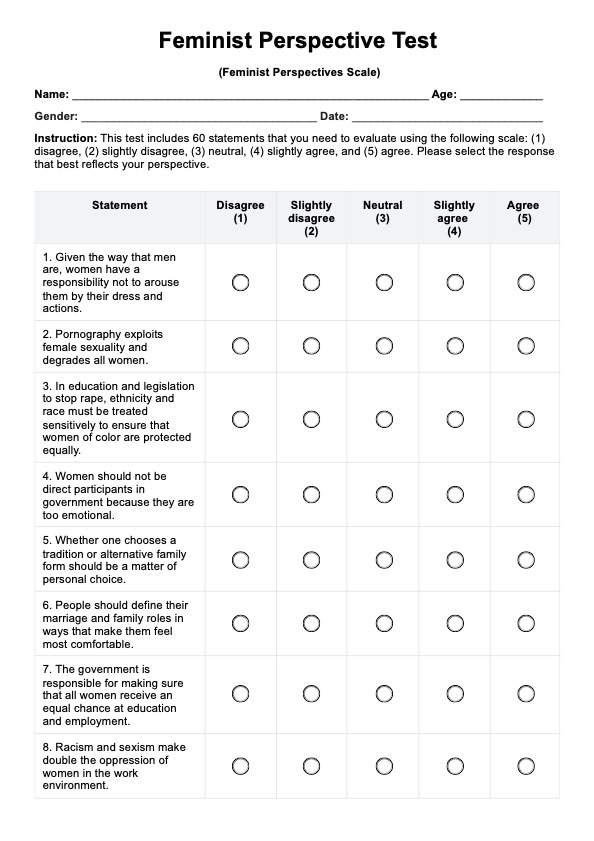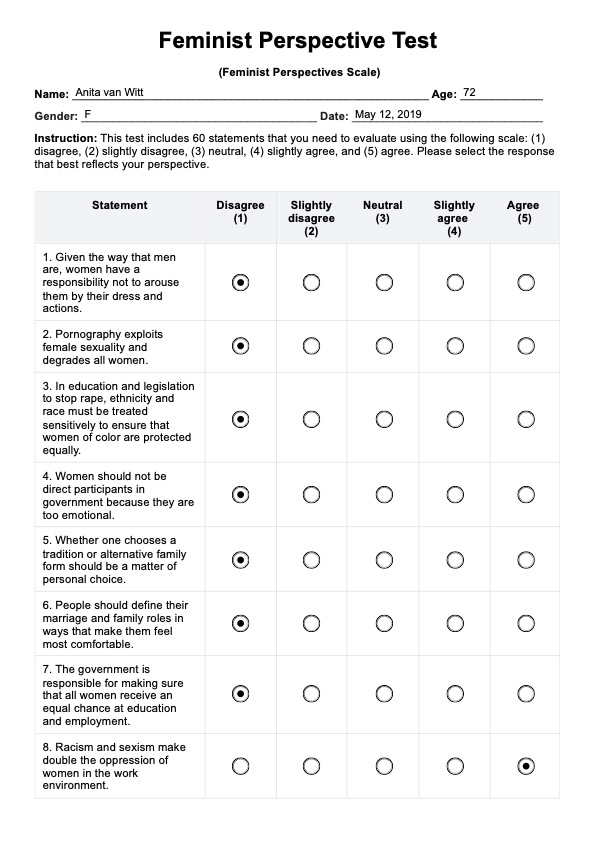Feminist Perspective Test
Discover the Feminist Perspective Test, a tool to assess feminist attitudes and beliefs. Learn how to conduct and score the test here.


What is the Feminist Perspective Test?
The Feminist Perspective Test, also known as the feminist perspective scale (FPS), is an assessment tool designed to evaluate individual attitudes and beliefs regarding gender equality and feminism. Developed by Nancy M. Henley and her colleagues in 1998, the FPS measures six distinct perspectives on feminism:
- Liberal feminism: This perspective advocates for equal rights and opportunities for women within society, striving to achieve equality through legal and political reforms.
- Radical feminism: Radical feminism views gender oppression as the most fundamental form of oppression, seeking to dismantle traditional gender roles and challenge male dominance over women.
- Socialist feminism: This approach examines how gender oppression is intertwined with class oppression. It posits that capitalism and patriarchy are interconnected systems that must be overthrown for true liberation.
- Cultural feminism: Cultural feminism celebrates and valorizes traditional feminine traits and roles, aiming to redefine femininity as positive and empowering.
- Womanism/Women of color feminism: Womanism highlights the multiple oppressions faced by women of color due to their race, class, and gender, emphasizing their unique experiences and perspectives.
- Conservatism: This perspective represents an anti-feminist stance that resists changes to traditional gender roles and the dynamics between men and women.
The FPS consists of 60 statements that participants evaluate on a 5-point scale from "disagree" to "agree." This tool provides a nuanced assessment of the diversity within feminist attitudes and beliefs.
Feminist Perspective Test Template
Feminist Perspective Test Example
How to use our Feminist Perspective Test template
Carepatron has created a simple Feminist Perspective Test template based on the FPS, allowing you to assess your clients' attitudes and beliefs about feminism. To use the template, follow these steps:
Step 1: Download the template
Download the Feminist Perspective Test template from Carepatron's website or directly from your Carepatron account.
Step 2: Administer the test to your client
Administer the test to your client, making sure they understand each statement and can provide their honest opinion. Alternatively, you can also send them an electronic copy of the test.
Step 3: Score the results
Using a scoring key provided in the template, calculate your client's scores for each perspective on feminism.
Step 4: Interpret the results
Based on your client's scores, you can interpret which perspectives on feminism they align with most strongly. This can help guide discussions and interventions related to gender and feminist issues.
Note that FPS scores are not definitive and should not be used as the sole measure of a person's beliefs or attitudes towards feminism. It is important to consider individual experiences, context, and other factors when interpreting the results.
Scoring and interpretation
The FPS differentiates between a general form of non-feminism, known as the conservative perspective, and six distinct types of feminism. Each perspective is represented by specific items:
- Conservative perspective: Items 1-10
- Liberal feminist perspective: Items 11-20
- Radical feminist perspective: Items 21-30
- Socialist feminist perspective: Items 31-40
- Cultural feminist perspective: Items 41-50
- Women of color perspective: Items 51-60
A higher score in a particular category reflects a stronger endorsement of that viewpoint. The scale not only provides scores for each feminist perspective but also calculates a total scale score by summing all 60 items. This total score serves as an overarching measure of feminist beliefs and attitudes, with higher scores indicating a greater alignment with feminist perspectives.
Interpreting these scores can be complex, as individuals often hold multiple and overlapping feminist beliefs. It's crucial to recognize that a high score in one perspective does not necessarily mean that a person rejects others. Rather, the scale provides a nuanced understanding of an individual's feminist beliefs, allowing for a more comprehensive assessment of their feminist identity.
Next steps after the test
After taking the Feminist Perspective Test, individuals can use their scores to continue exploring and reflecting on their feminist beliefs. The results can also facilitate discussions with others, as a tool for understanding and connecting with different perspectives.
You can also use the results to identify areas for personal growth and development in your client's feminist identity. For example, if your client scores low on the socialist feminist perspective, you may explore ways for them to incorporate more intersectionality and class-based analysis into their understanding of feminism.
Additionally, further research and education can help individuals deepen their understanding of each perspective and how they intersect with one another. This can include reading articles or books written by feminists from various perspectives, attending workshops or seminars on feminist theory, or engaging in discussions with others who hold different viewpoints.
Reference
Henley, N.; Meng, K.; O'Brien, D.; McCarthy, W.; Sockloskie, R. (1998). Developing a scale to measure the diversity of feminist attitudes. Psychology of Women Quarterly, 22(2), 317-348.
Commonly asked questions
An example of a feminist perspective is the examination of how gender roles and expectations shape societal norms and individual experiences. Feminist theorists often analyze literature, media, and culture to highlight the ways in which women are represented and to challenge stereotypes that perpetuate inequality. By focusing on women's experiences and advocating for their rights, this perspective seeks to promote gender equality and social justice.
The feminist perspective theory refers to a framework for understanding how gender impacts social structures, behaviors, and relationships. It emphasizes the importance of viewing issues through a gendered lens, asserting that many societal problems are rooted in patriarchal systems that prioritize male experiences and perspectives. This theory advocates for the inclusion of women's voices and experiences in discussions about power, politics, and society.
The feminist perspective scale is a measurement tool that assesses individuals' beliefs and attitudes towards gender and feminism. This scale typically includes a range of statements related to feminist ideals, gender equality, and the role of women in society.
The three main feminist approaches include liberal feminism, radical feminism, and socialist feminism. Liberal feminism focuses on achieving gender equality through legal and political reforms, advocating for women's rights within existing societal structures. Radical feminism, on the other hand, seeks to dismantle patriarchy altogether, arguing that systemic changes are necessary to achieve true gender equality. Socialist feminism combines aspects of both, emphasizing the interplay between capitalism and patriarchy, and advocating for social and economic changes alongside gender equality initiatives.

.jpg)


















-template.jpg)



















































































